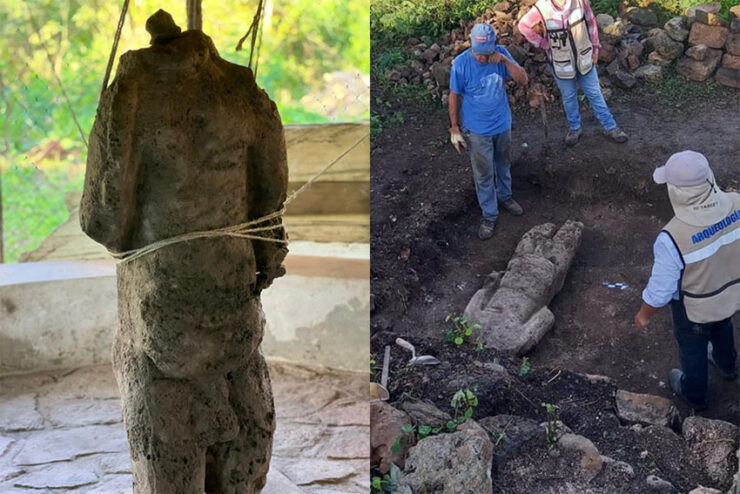A life-size sculpture of a headless figure discovered during excavation work for the Maya Train has been dubbed “Yum keeb” – the deity of the phallus or fertility. The discovery took place in the Yucatán state, in the archaeological zone of Oxkintok, some 55 kilometers south of Mérida. The limestone statue is 1.65 meters tall, or roughly 5 feet 5 inches, without a head, hands, lower legs, or feet.
Archaeologist Luis Pantoja Daz remarked during a media tour of the location on Wednesday: “He was found lying on his back and represents the human figure. We see the marked pectorals, the middle part that could be the hanging belly and the part of the member.” He also claimed that certain lines on the back, such as those separating the shoulder blades, and the buttocks, both of which are plainly apparent in the photograph, could be seen.
While the daily La Jornada referred to the sculpture as a “phallus” and a “member,” another publication published nothing along those lines or regarding “fertilidad,” (fertility) stating that the sculpture is really that of a “fighter.” According to Diego Prieto, general director of the National Institute of Anthropology and History (INAH), as described by El Financiero, the object’s absence of a head “certainly indicates a warrior who was a prisoner in fight.”
According to both versions, the headless figure may have been presented to the gods as an offering. It was discovered close to a stairway covered with hieroglyphs that was being cleaned and rebuilt. Pantoja Daz emphasized that the figure is still being examined to ascertain its precise purpose, hence the appellation “temporary.” Even the statue’s image of a man is not certain to be a man, he continued.
Before Uxmal rose to prominence, Oxkintok served as the region’s capital throughout the second half of the Mesomerican Classic Period (A.D. 250 to 900). It is known for its ancient landmarks, including as pyramids and monuments, and is tucked away amidst mountains that are overgrown, with many unexplored possibilities.
According to the news of Mexico News Daily, the Maya Train is divided into seven sections, and according to reports, the INAH has finished excavation operations in sections 1-3 and 5, with sections 6 and 7 still in the prospecting stage.
Discoveries on the entire Maya Train route include 31,306 structures, 1,541 ceramics and chiseled stones, 463 sets of bones or skeletons, 1,040 natural features such as caves and cenotes, 708,428 ceramic figures and fragments (from sections 1-4), and 576 pieces in the process of analysis.
The Maya Train, one of President Andrés Manuel Lopéz Obrador’s most ambitious projects, will run through Tabasco, Chiapas, Campeche, Yucatán, and Quintana Roo, and has been plagued by many challenges and issues. According to reports, the initial budget of nearly $8 billion in 2020 has now been increased to up to $20 billion.
Cover photo: Mexico News Daily
